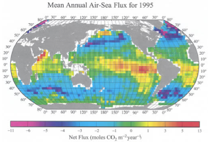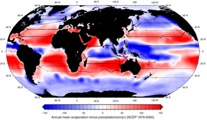Regional and time-dependent aspects of Indian Ocean diapycnal processes
Asymetries
Indian Ocean surface fluxes are highly asymmetric (e.g. Fig. 1.5). Much of the asymmetry in the northern basin is due to the monsoon reversals that create reversing Ekman transports, seasonal upwelling, and strong seasonality in air-sea fluxes. Surface heat flux, surface CO2 outgassing and surface evaporation are highest in the western tropics, including the Arabian Sea upwelling region. These imply that flux divergences within the water column must also be asymmetric. We propose to investigate the effect of east-west and other regional asymmetries, so often neglected in studies of overturning, on the carbon, anthropogenic carbon, oxygen, heat and freshwater transports and divergences within the Indian Ocean.
An equally or even more important asymmetry is associated with the complex basin geometry. The Indian Ocean is subdivided by numerous ridges with rough topography. Tidal energy is focused in the western Indian Ocean, which just happens to overly the very rough Southwest Indian Ridge. Diffusivity estimates based on direct velocity measurements made during the 1995 WOCE survey show enhanced diffusivity associated with portions of these ridges (Kunze et al., 2006) (Fig. 1.6). The Kerguelen hotspot is apparently not associated with the tides, but with the deflection of the Antarctic Circumpolar Current.
New diffusivity estimates based on LADCP observations from this 1995 data set suggest much stronger diffusivity over the Southwest Indian Ridge and near Kerguelen (Kunze et al., 2006), and confirmed with intensive local observations (Mackinnon et al., 2008). Greatly enhanced diffusivities (10 to 100 times the open ocean value) in other gaps in ridges in the Indian Ocean (and elsewhere) are associated with disappearance (diapycnal mixing) of bottom waters into the layers above downstream of the gaps (e.g. Whitehead, 1998; McCarthy, Talley and Baringer, 1997; Sloyan, 2006); these are important for water masses filling the basins downstream, and don’t have a signature in the LADCP-based map.

